Strength Behaviors of Remolded Hydrate-Bearing Marine Sediments in Different Drilling Depths of the South China Sea
Abstract
1. Introduction
2. Experimental Methods
2.1. Apparatus
2.2. Marine Sediments
2.3. Sample Preparation and Shear Process
3. Results and Discussion
3.1. Effect of Drilling Depth
3.2. Effect of Hydrate Saturation and Existence Form of Hydrate
3.3. Effect of Hydrate Dissociation
4. Conclusions
Author Contributions
Funding
Conflicts of Interest
References
- Dai, S.; Santamarina, J. Sampling disturbance in hydrate-bearing sediment pressure cores: NGHP-01 expedition, Krishna–Godavari Basin example. Mar. Pet. Geol. 2014, 58, 178–186. [Google Scholar] [CrossRef]
- Dawe, R.; Thomas, S. A Large Potential Methane Source—Natural Gas Hydrates. Energy Sources Part A 2007, 29, 217–229. [Google Scholar] [CrossRef]
- Lee, S.; Holder, G. Methane hydrates potential as a future energy source. Fuel Process. Technol. 2001, 71, 181–186. [Google Scholar] [CrossRef]
- Kuang, Y.; Lei, X.; Yang, L.; Zhao, Y.; Zhao, J. Observation of In Situ Growth and Decomposition of Carbon Dioxide Hydrate at Gas–Water Interfaces Using Magnetic Resonance Imaging. Energy Fuels 2018, 32, 6964–6969. [Google Scholar] [CrossRef]
- Yang, L.; Ai, L.; Xue, K.; Ling, Z.; Li, Y. Analyzing the effects of inhomogeneity on the permeability of porous media containing methane hydrates through pore network models combined with CT observation. Energy 2018, 163, 27–37. [Google Scholar] [CrossRef]
- Martens, C.; Mendlovitz, H.; Seim, H.; Lapham, L.; D’Emidio, M. Sustained in situ measurements of dissolved oxygen, methane and water transport processes in the benthic boundary layer at MC118, northern Gulf of Mexico. Deep Sea Res. Part II 2016, 129, 41–52. [Google Scholar] [CrossRef]
- Rose, K.; Boswell, R.; Collett, T. Mount Elbert Gas Hydrate Stratigraphic Test Well, Alaska North Slope: Coring operations, core sedimentology, and lithostratigraphy. Mar. Pet. Geol. 2011, 28, 311–331. [Google Scholar] [CrossRef]
- Usapkar, A.; Dewangan, P.; Kocherla, M.; Ramprasad, T.; Mazumdar, A.; Ramana, M. Enhanced methane flux event and sediment dispersal pattern in the Krishna–Godavari offshore basin: Evidences from rock magnetic techniques. Mar. Pet. Geol. 2014, 58, 461–475. [Google Scholar] [CrossRef]
- Yoneda, J.; Masui, A.; Konno, Y.; Jin, Y.; Egawa, K.; Kida, M.; Ito, T.; Nagao, J.; Tenma, N. Mechanical behavior of hydrate-bearing pressure-core sediments visualized under triaxial compression. Mar. Pet. Geol. 2015, 66, 451–459. [Google Scholar] [CrossRef]
- Li, G.; Moridis, G.J.; Zhang, K.; Li, X. Evaluation of gas production potential from marine gas hydrate deposits in Shenhu area of South China Sea. Energy Fuels 2010, 24, 6018–6033. [Google Scholar] [CrossRef]
- Li, G.; Moridis, G.J.; Zhang, K.; Li, X. The use of huff and puff method in a single horizontal well in gas production from marine gas hydrate deposits in the Shenhu Area of South China Sea. J. Pet. Sci. Eng. 2011, 77, 49–68. [Google Scholar] [CrossRef]
- Sun, J.; Zhang, L.; Ning, F.; Lei, W.; Liu, L.; Hu, W.; Lu, H.; Lu, J.; Liu, C.; Jiang, G.; et al. Production potential and stability of hydrate-bearing sediments at the site GMGS3-W19 in the South China Sea: A preliminary feasibility study. Mar. Pet. Geol. 2017, 86, 447–473. [Google Scholar] [CrossRef]
- Brown, H.; Holbrook, W.; Hornbach, M.; Nealon, J. Slide structure and role of gas hydrate at the northern boundary of the Storegga Slide, offshore Norway. Mar. Geol. 2006, 229, 179–186. [Google Scholar] [CrossRef]
- Clayton, C.R.I.; Priest, J.A.; Rees, E.V.L. The effects of hydrate cement on the stiffness of some sands. Géotechnique 2010, 60, 435–445. [Google Scholar] [CrossRef]
- Kim, Y.; Lee, S.; Jin, Y.; Baranov, B.; Obzhirov, A.; Salomatin, A.; Shoji, H. The stability of gas hydrate field in the northeastern continental slope of Sakhalin Island, Sea of Okhotsk, as inferred from analysis of heat flow data and its implications for slope failures. Mar. Pet. Geol. 2013, 45, 198–207. [Google Scholar] [CrossRef]
- Kvenvolden, K.; Ginsburg, G.; Soloviev, V. Worldwide distribution of subaquatic gas hydrates. Geo-Mar. Lett. 1993, 13, 32–40. [Google Scholar] [CrossRef]
- Sun, X.; Guo, X.; Shao, L.; Tang, H. A thermodynamics-based critical state constitutive model for methane hydrate bearing sediment. J. Nat. Gas Sci. Eng. 2015, 27, 1024–1034. [Google Scholar] [CrossRef]
- Sun, X.; Hao, L.; Soga, K. A coupled thermal–hydraulic–mechanical–chemical (THMC) model for methane hydrate bearing sediments using COMSOL Multiphysics. J. Zhejiang Univ. Sci. A 2018, 19, 600–623. [Google Scholar] [CrossRef]
- Grozic, J.; Ghiassian, H. Undrained shear strength of methane hydrate-bearing sand; preliminary laboratory results. In Proceedings of the 6th Canadian permafrost conference and 63rd Canadian geotechnical conference, Calgary, CA, USA, 12–16 September 2010; pp. 459–466. [Google Scholar]
- Hyodo, M.; Nakata, Y.; Yoshimoto, N.; Fukunaga, M.; Kubo, K.; Nanjo, Y.; Matsuo, T.; Nakamura, K. Triaxial Compressive Strength of Methane Hydrate. In Proceedings of the International Offshore and Polar Engineering Conference, Kitakyushu, Japan, 26–31 May 2002. [Google Scholar]
- Hyodo, M.; Nakata, Y.; Yoshimoto, N.; Yoneda, J. Shear strength of methane hydrate bearing sand and its deformation during dissociation of methane hydrate. In Proceedings of the 4th International Symposium on Deformation Characteristics of Geomaterials, Georgia, GA, USA, 15 September 2008; pp. 549–556. [Google Scholar]
- Hyodo, M.; Nakata, Y.; Yoshimoto, N.; Orense, R.; Yoneda, J.; Nakagawa, M.; Luding, S. Bonding Strength by Methane Hydrate Formed among Sand Particles. AIP Conf. Proc. 2009, 1145, 79–82. [Google Scholar]
- Hyodo, M.; Li, Y.; Yoneda, J.; Nakata, Y.; Yoshimoto, N.; Nishimura, A.; Song, Y. Mechanical behavior of gas–saturated methane hydrate–bearing sediments. J. Geophys. Res. 2013, 118, 5185–5194. [Google Scholar] [CrossRef]
- Hyodo, M.; Li, Y.; Yoneda, J.; Nakata, Y.; Yoshimoto, N.; Nishimura, A. Effects of dissociation on the shear strength and deformation behavior of methane hydrate-bearing sediments. Mar. Pet. Geol. 2014, 51, 52–62. [Google Scholar] [CrossRef]
- Li, Y.; Liu, W.; Zhu, Y.; Chen, Y.; Song, Y.; Li, Q. Mechanical behaviors of permafrost-associated methane hydrate-bearing sediments under different mining methods. Appl. Energy 2016, 162, 1627–1632. [Google Scholar] [CrossRef]
- Li, Y.; Song, Y.; Liu, W.; Yu, F. Experimental research on the mechanical properties of methane hydrate-ice mixtures. Energies 2012, 5, 181–192. [Google Scholar] [CrossRef]
- Li, Y.; Song, Y.; Yu, F.; Liu, W.; Zhao, J. Experimental study on mechanical properties of gas hydrate-bearing sediments using kaolin clay. China Ocean Eng. 2011, 25, 113–122. [Google Scholar] [CrossRef]
- Liu, W.; Li, Y.; Xu, X.; Song, Y. Study on Influence Factors of Methane Hydrate Formation from Ice: Temperature, Pressure and SDS Surfactant. Chin. J. Chem. Eng. 2018. [Google Scholar] [CrossRef]
- Liu, W.; Luo, T.; Li, Y.; Song, Y.; Zhu, Y.; Liu, Y.; Zhao, J.; Wu, Z.; Xu, X. Experimental study on the mechanical properties of sediments containing CH4 and CO2 hydrate mixtures. J. Nat. Gas Sci. Eng. 2016, 32, 20–27. [Google Scholar] [CrossRef]
- Liu, W.; Wu, Z.; Li, Y.; Song, Y.; Ling, Z.; Zhao, J.; Lv, Q. Experimental study on the gas phase permeability of methane hydrate-bearing clayey sediments. J. Nat. Gas Sci. Eng. 2016, 36, 378–384. [Google Scholar] [CrossRef]
- Miyazaki, K.; Masui, A.; Aoki, K.; Sakamoto, Y.; Yamaguchi, T.; Okubo, S. Strain-rate dependence of triaxial compressive strength of artificial methane-hydrate-bearing sediment. Int. J. Offshore Polar Eng. 2010, 20. [Google Scholar]
- Miyazaki, K.; Masui, A.; Sakamoto, Y.; Aoki, K.; Tenma, N.; Yamaguchi, T. Triaxial compressive properties of artificial methane-hydrate-bearing sediment. J. Geophys. Res. 2011, 116. [Google Scholar] [CrossRef]
- Miyazaki, K.; Tenma, N.; Aoki, K.; Sakamoto, Y.; Yamaguchi, T. Effects of confining pressure on mechanical properties of artificial methane-hydrate-bearing sediment in triaxial compression test. Int. J. Offshore Polar Eng. 2011, 21. [Google Scholar]
- Wu, Z.; Li, Y.; Sun, X.; Li, M.; Jia, R. Experimental study on the gas phase permeability of montmorillonite sediments in the presence of hydrates. Mar. Pet. Geol. 2018, 91, 373–380. [Google Scholar] [CrossRef]
- Wu, Z.; Li, Y.; Sun, X.; Wu, P.; Zheng, J. Experimental study on the effect of methane hydrate decomposition on gas phase permeability of clayey sediments. Appl. Energy 2018, 230, 1304–1310. [Google Scholar] [CrossRef]
- Grozic, J. Interplay between Gas Hydrates and Submarine Slope Failure, Submarine Mass Movements and Their Consequences; Springer: Berlin, Germany, 2010; pp. 11–30. [Google Scholar]
- Hyodo, M.; Nishimura, A.; Kajiyama, S. Effect of fines on shear strength of methane hydrate bearing sand. In Proceedings of the Eleventh Ocean Mining and Gas Hydrates Symposium, Kona, HI, USA, 21–27 June 2015. [Google Scholar]
- Luo, T.; Li, Y.; Liu, W.; Sun, X.; Shen, S. Experimental Study on the Mechanical Properties of CH4 and CO2 Hydrate Remodeling Cores in Qilian Mountain. Energies 2017, 10, 2078. [Google Scholar] [CrossRef]
- Luo, T.; Li, Y.; Sun, X.; Shen, S.; Wu, P. Effect of sediment particle size on the mechanical properties of CH4 hydrate-bearing sediments. J. Pet. Sci. Eng. 2018, 171, 302–314. [Google Scholar] [CrossRef]
- Madhusudhan, B.N.; Clayton, C.; Priest, J.A. The effects of hydrate on the strength and stiffness of some sands. J. Geophys. Res. 2018. [Google Scholar] [CrossRef]
- Miyazaki, K.; Tenma, N.; Aoki, K.; Yamaguchi, T. A Nonlinear Elastic Model for Triaxial Compressive Properties of Artificial Methane-Hydrate-Bearing Sediment Samples. Energies 2012, 5, 4057–4075. [Google Scholar] [CrossRef]
- Yoneda, J.; Hyodo, M.; Yoshimoto, N.; Nakata, Y.; Kato, A. Development of high-pressure low-temperature plane strain testing apparatus for methane hydrate-bearing sand. Soils Found. 2013, 53, 774–783. [Google Scholar] [CrossRef]
- Yoneda, J.; Masui, A.; Konno, Y.; Jin, Y.; Egawa, K.; Kida, M.; Ito, T.; Nagao, J.; Tenma, N. Mechanical properties of hydrate-bearing turbidite reservoir in the first gas production test site of the Eastern Nankai Trough. Mar. Pet. Geol. 2015, 66, 471–486. [Google Scholar] [CrossRef]
- Yun, T.; Santamarina, J.; Ruppel, C. Mechanical properties of sand, silt, and clay containing tetrahydrofuran hydrate. J. Geophys. Res. 2007, 112. [Google Scholar] [CrossRef]
- Masui, A.; Haneda, H.; Ogata, Y.; Aoki, K. Effects of methane hydrate formation on shear strength of synthetic methane hydrate sediments. In Proceedings of the Fifteenth International Offshore and Polar Engineering Conference, Seoul, Korea, 19–24 June 2005. [Google Scholar]
- Masui, A.; Haneda, H.; Ogata, Y.; Aoki, K. Mechanical properties of sandy sediment containing marine gas hydrates in deep sea offshore Japan. In Proceedings of the Seventh ISOPE Ocean Mining Symposium, Lisbon, Portugal, 1–6 July 2007. [Google Scholar]
- Winters, W.; Wilcox-Cline, R.; Long, P.; Dewri, S.; Kumar, P.; Stern, L.; Kerr, L. Comparison of the physical and geotechnical properties of gas-hydrate-bearing sediments from offshore India and other gas-hydrate-reservoir systems. Mar. Pet. Geol. 2014, 58, 139–167. [Google Scholar] [CrossRef]
- Hyodo, M.; Nakata, Y.; Yoshimoto, N.; Kbimuna, T. Basic research on the mechanical behavior of methane hydrate-sediments mixture. J. Jpn. Geotech. Soc. 2005, 45, 75–85. [Google Scholar]
- Hyodo, M.; Yoneda, J.; Yoshimoto, N.; Nakata, Y. Mechanical and dissociation properties of methane hydrate-bearing sand in deep seabed. Soils Found. 2013, 53, 299–314. [Google Scholar] [CrossRef]
- Yoneda, J.; Masui, A.; Konno, Y.; Jin, Y.; Kida, M.; Katagiri, J.; Nagao, J.; Tenma, N. Pressure-core-based reservoir characterization for geomechanics: Insights from gas hydrate drilling during 2012–2013 at the eastern Nankai Trough. Mar. Pet. Geol. 2017, 86, 1–16. [Google Scholar] [CrossRef]
- Luo, T.; Song, Y.; Zhu, Y.; Liu, W.; Liu, Y.; Li, Y.; Wu, Z. Triaxial experiments on the mechanical properties of hydrate-bearing marine sediments of South China Sea. Mar. Pet. Geol. 2016, 77, 507–514. [Google Scholar] [CrossRef]
- Priest, J.; Clayton, C.; Rees, E. Potential impact of gas hydrate and its dissociation on the strength of host sediment in the Krishna–Godavari Basin. Mar. Pet. Geol. 2014, 58, 187–198. [Google Scholar] [CrossRef]
- Yun, T.; Fratta, D.; Santamarina, J. Hydrate-Bearing Sediments from the Krishna−Godavari Basin: Physical Characterization, Pressure Core Testing, and Scaled Production Monitoring. Energy Fuels 2010, 24, 5972–5983. [Google Scholar] [CrossRef]
- Liu, C.; Ye, Y.; Meng, Q.; He, X.; Lu, H.; Zhang, J.; Liu, J.; Yang, S. The characteristics of gas hydrates recovered from Shenhu Area in the South China Sea. Mar. Geol. 2012, 307, 22–27. [Google Scholar] [CrossRef]
- Miyazaki, K.; Tenma, N.; Aoki, K.; Sakamoto, Y.; Yamaguchi, T. Loading-Rate Dependence of Triaxial Compressive Strength of Artificial Methane-Hydrate-Bearing Sediment Containing Fine Fraction. In Proceedings of the International Society of Offshore and Polar Engineers, Rhodes, Greece, 26 June–1 July 2012; pp. 17–22. [Google Scholar]
- Yu, F.; Song, Y.; Liu, W.; Li, Y.; Lam, W. Analyses of stress strain behavior and constitutive model of artificial methane hydrate. J. Pet. Sci. Eng. 2011, 77, 183–188. [Google Scholar] [CrossRef]
- Hyodo, M.; Li, Y.; Yoneda, J.; Nakata, Y.; Yoshimoto, N.; Kajiyama, S.; Nishimura, A.; Song, Y. A comparative analysis of the mechanical behavior of carbon dioxide and methane hydrate-bearing sediments. Am. Mineral. 2014, 99, 178–183. [Google Scholar] [CrossRef]

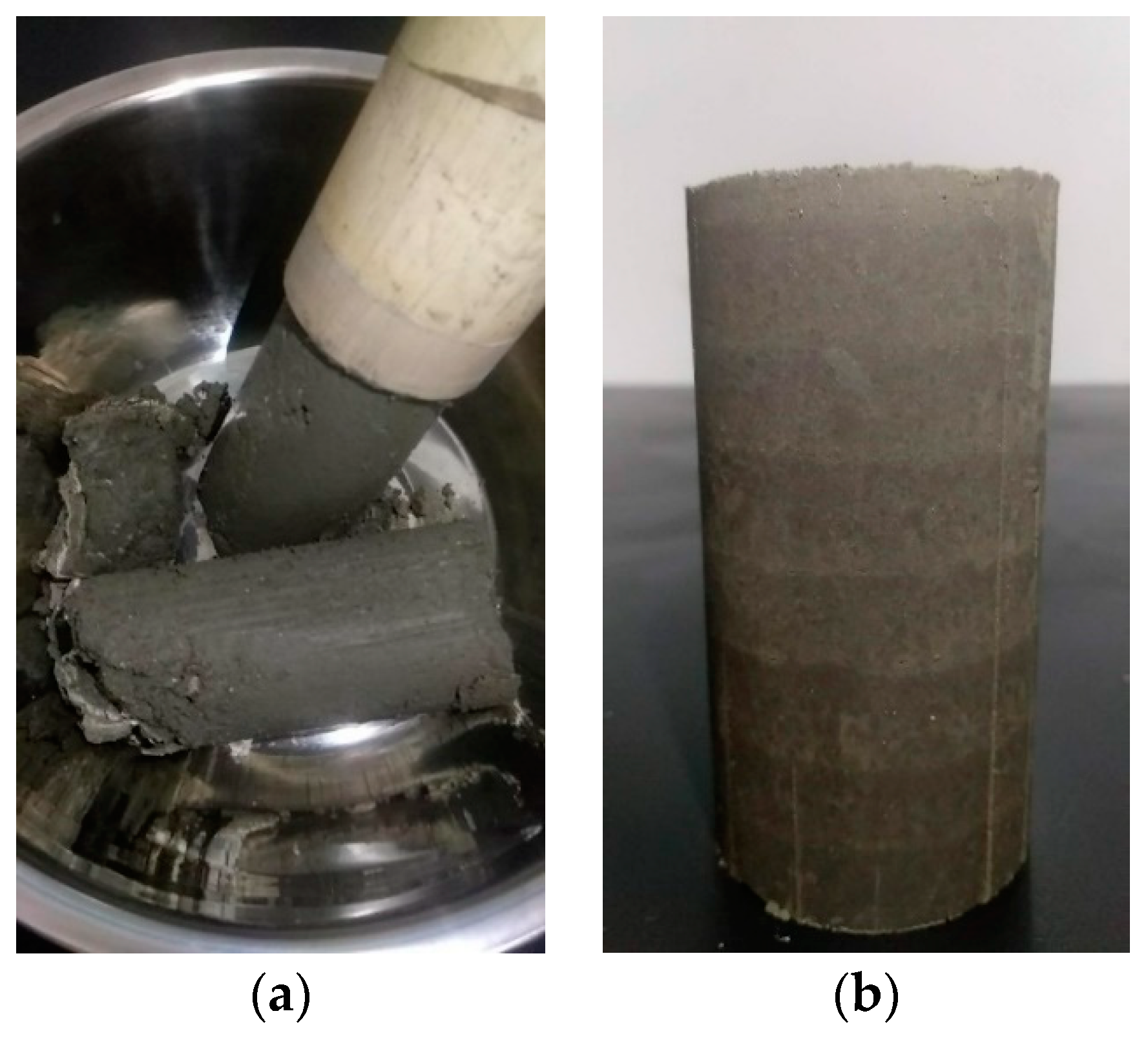
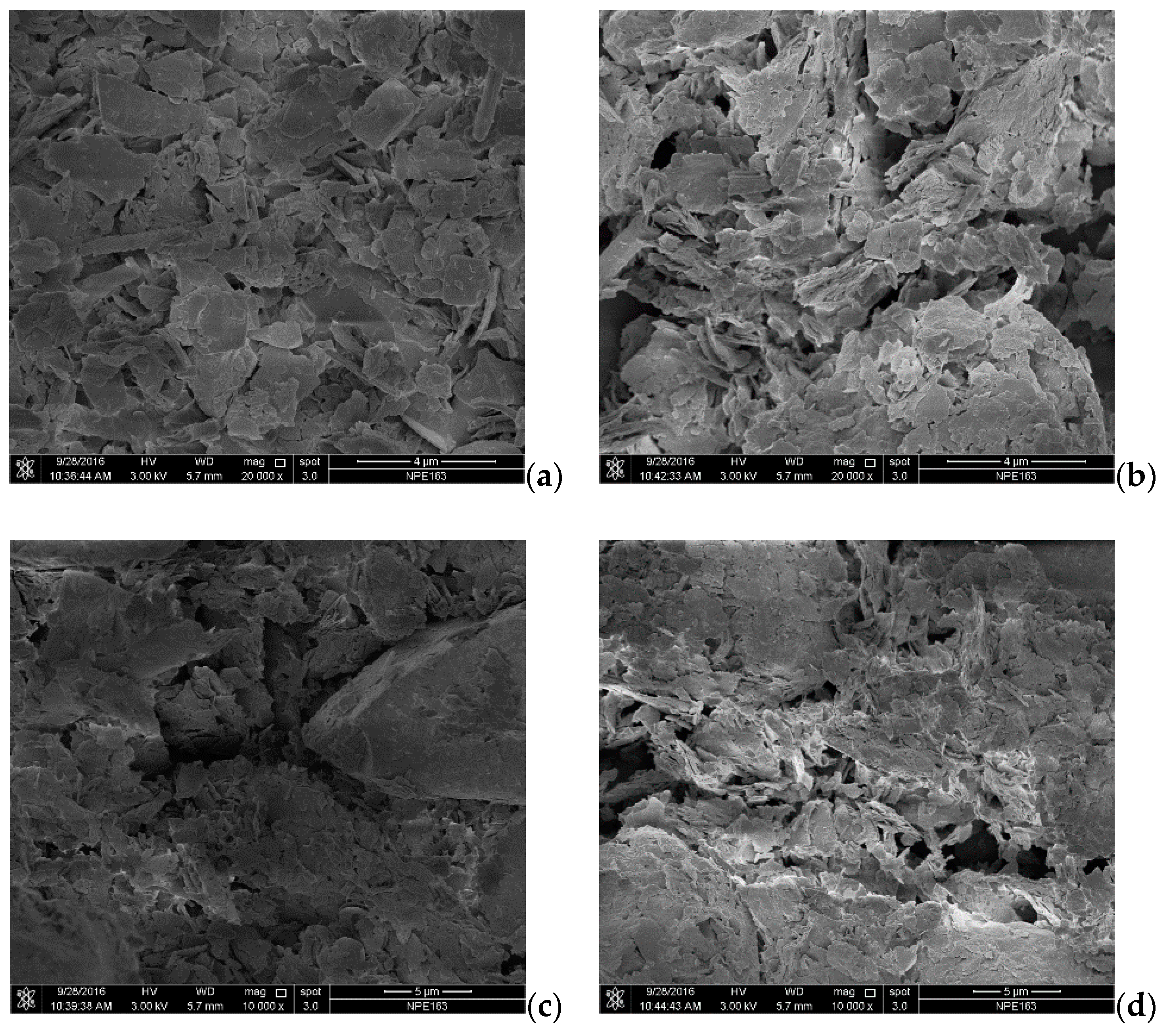
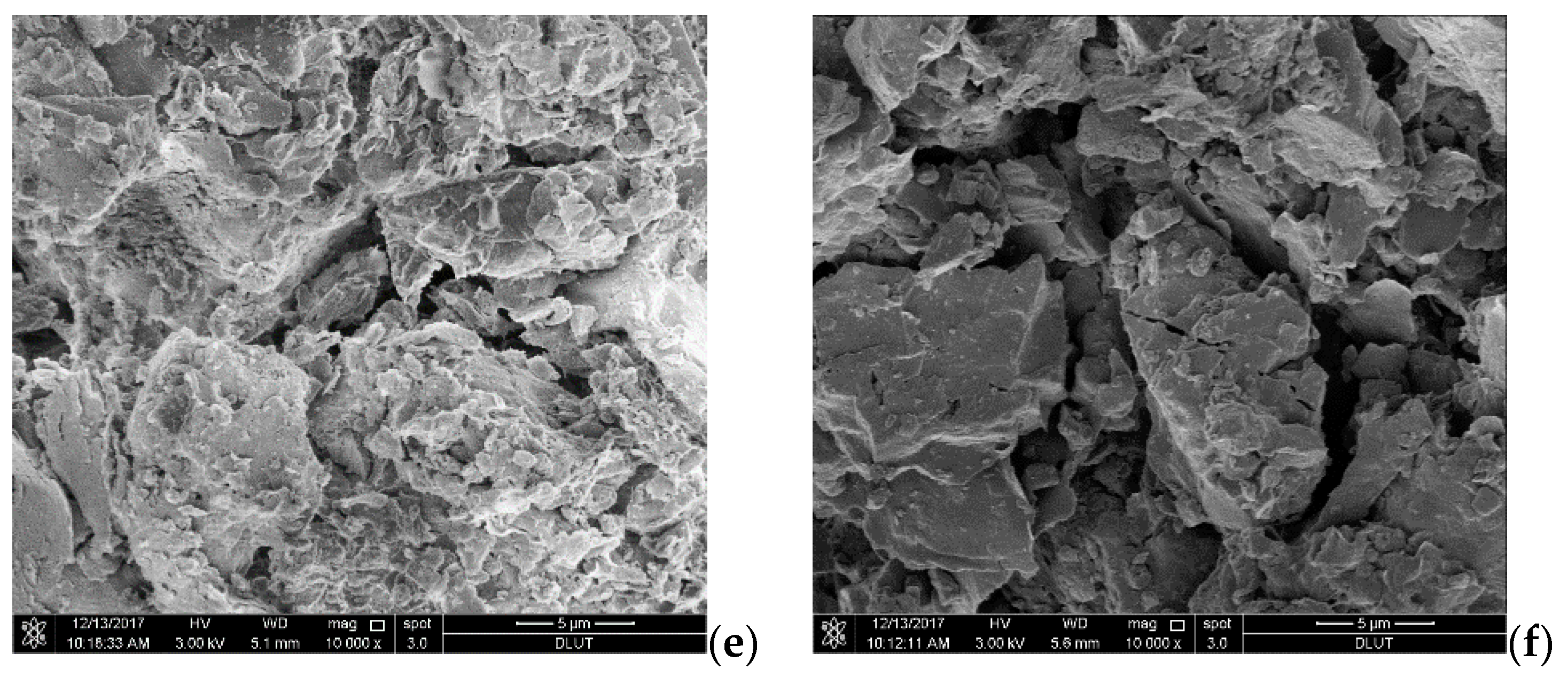
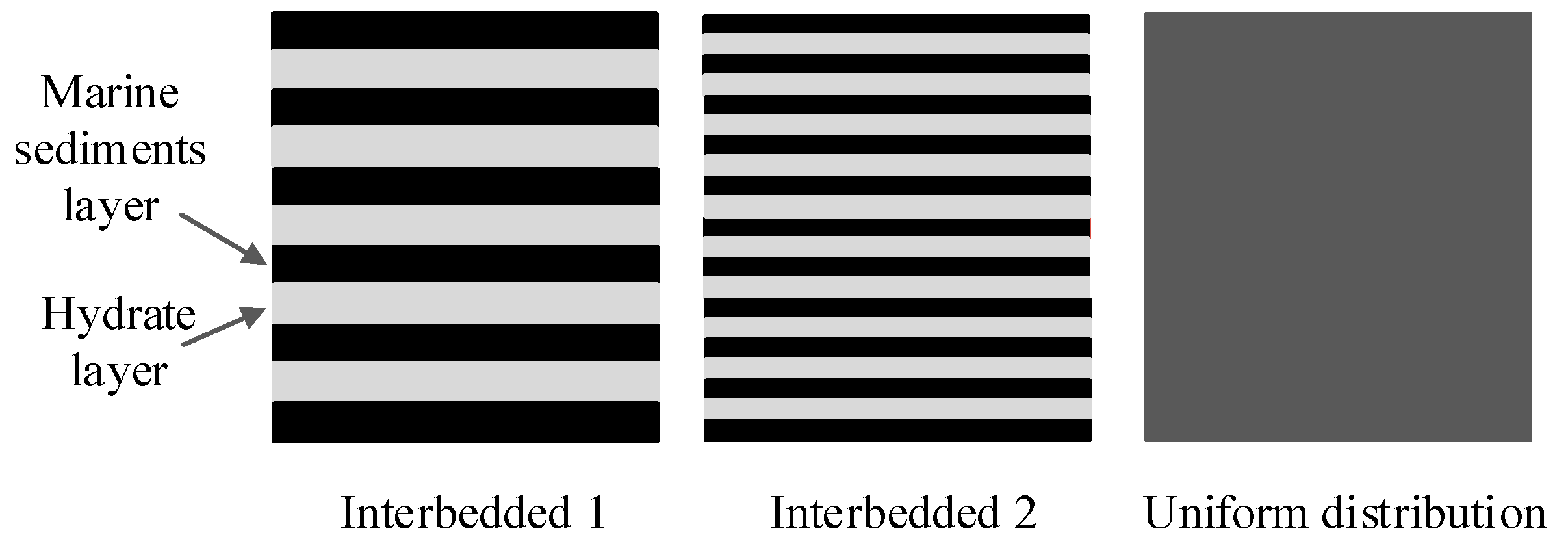
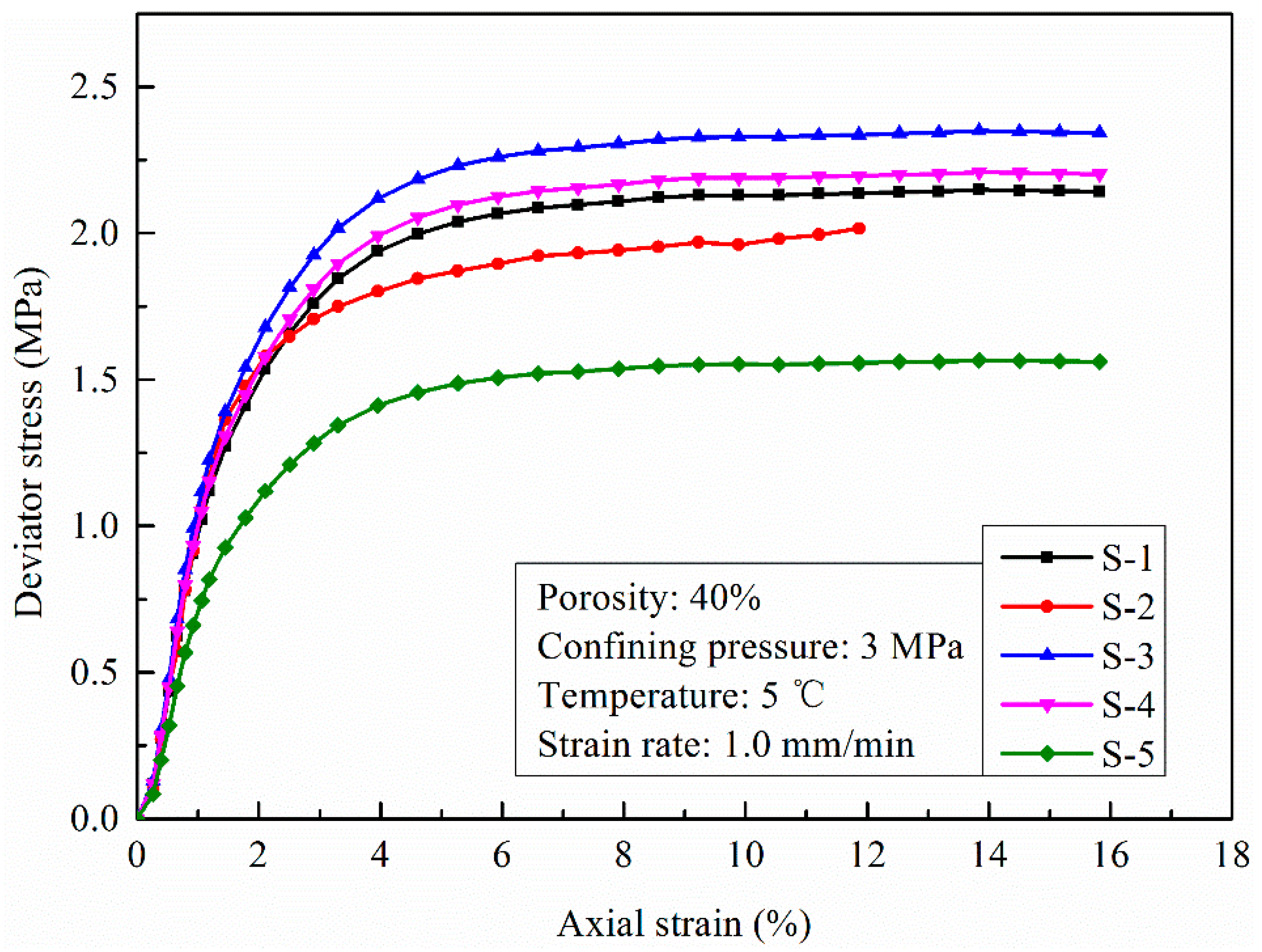

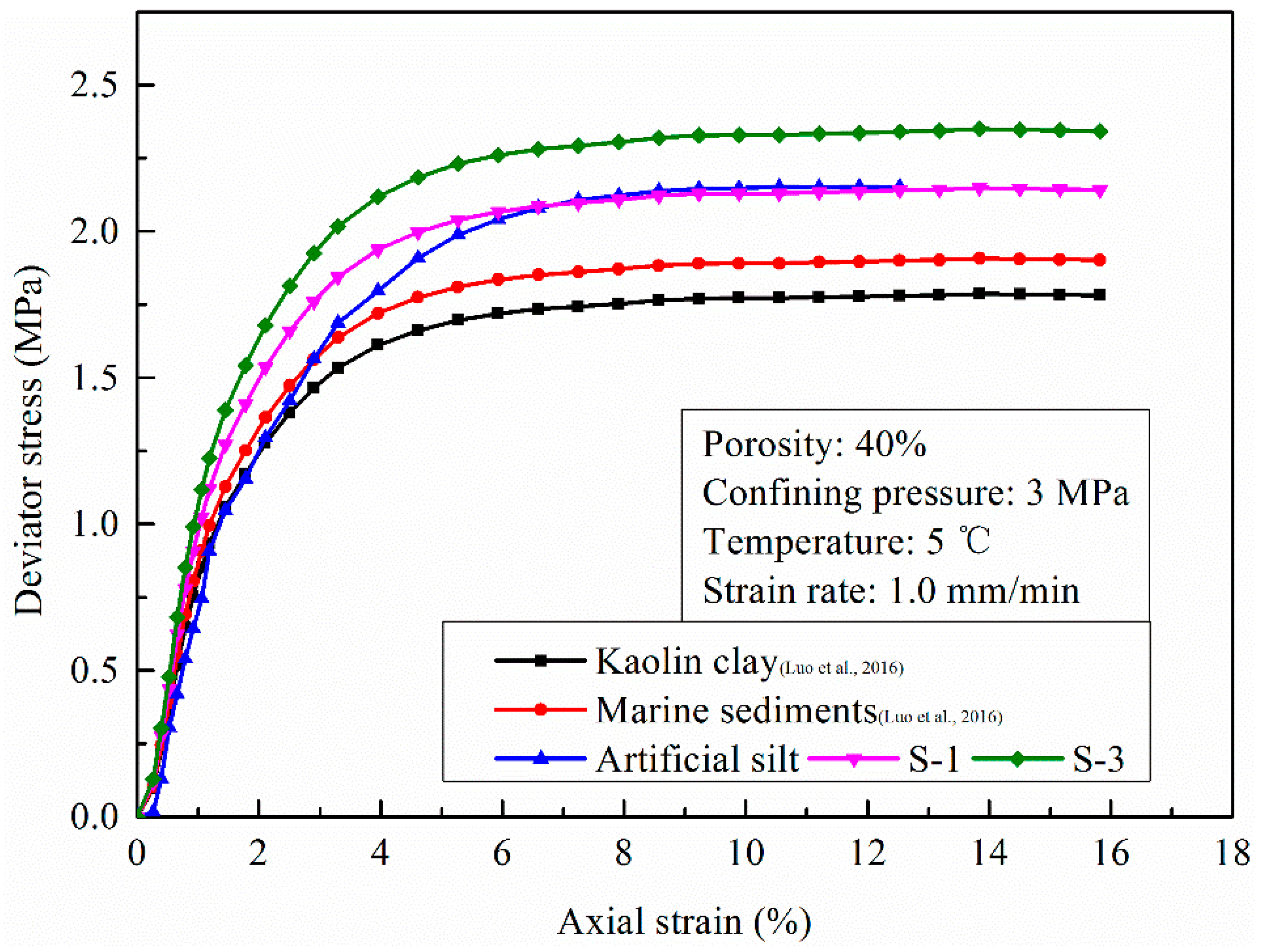
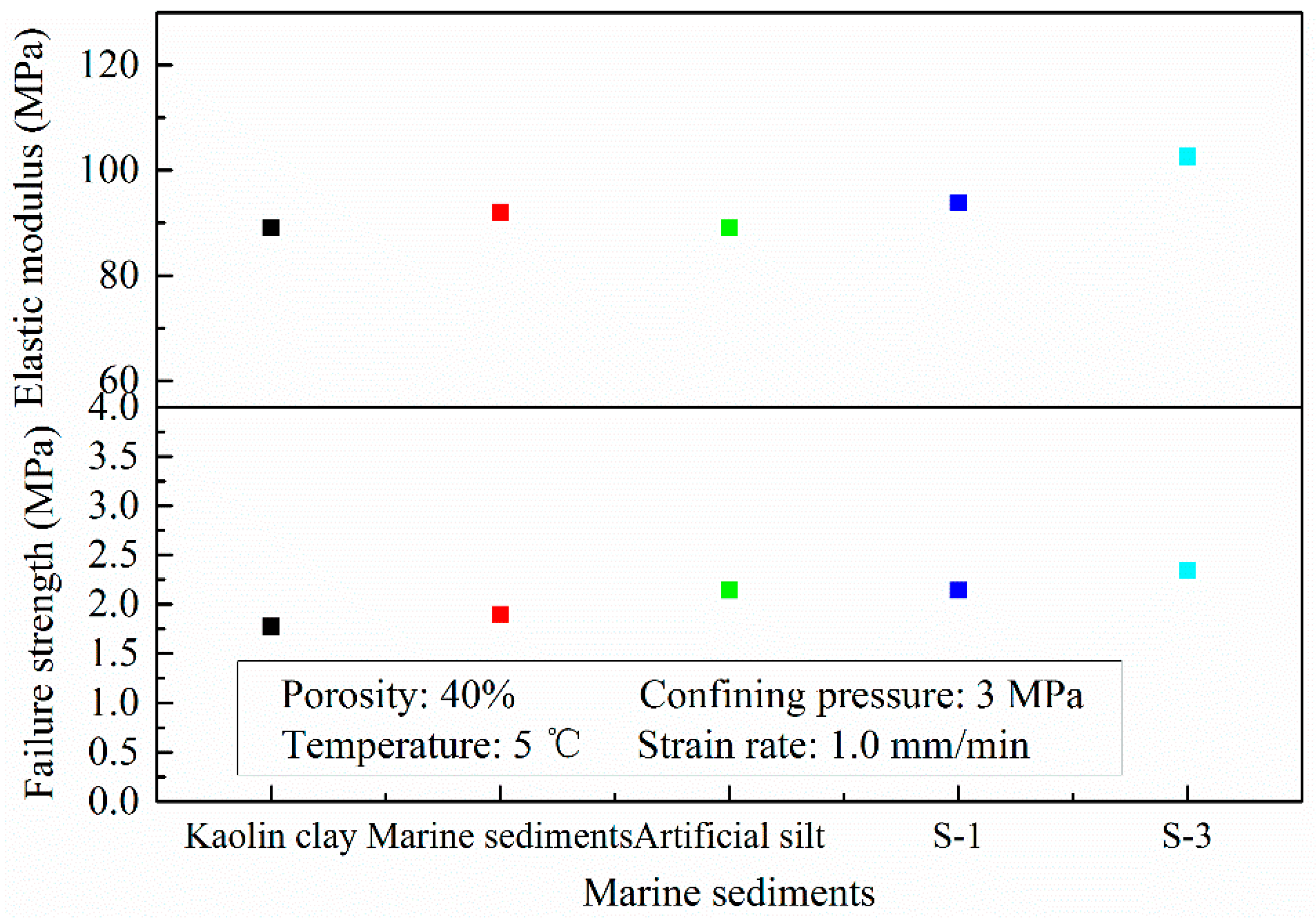
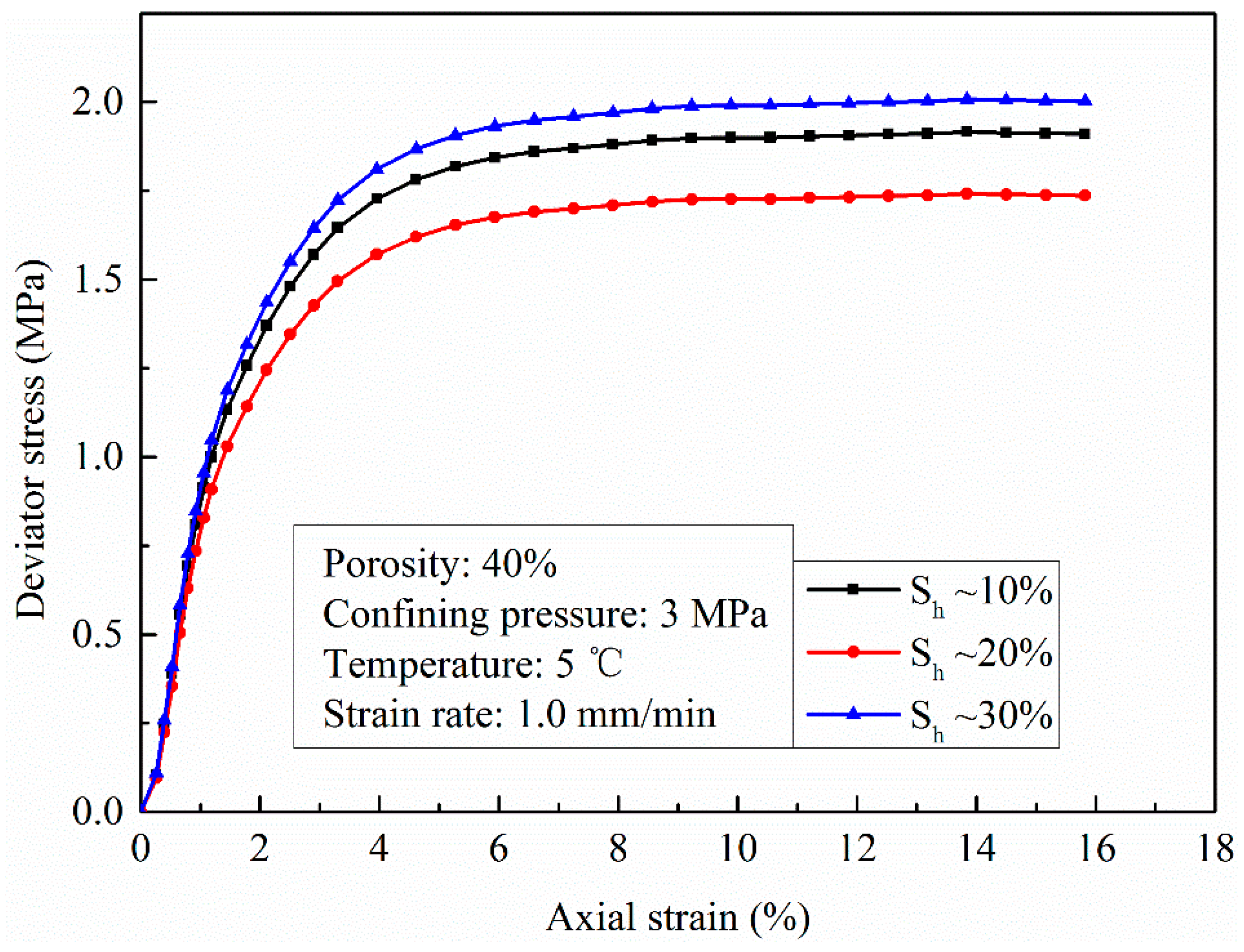
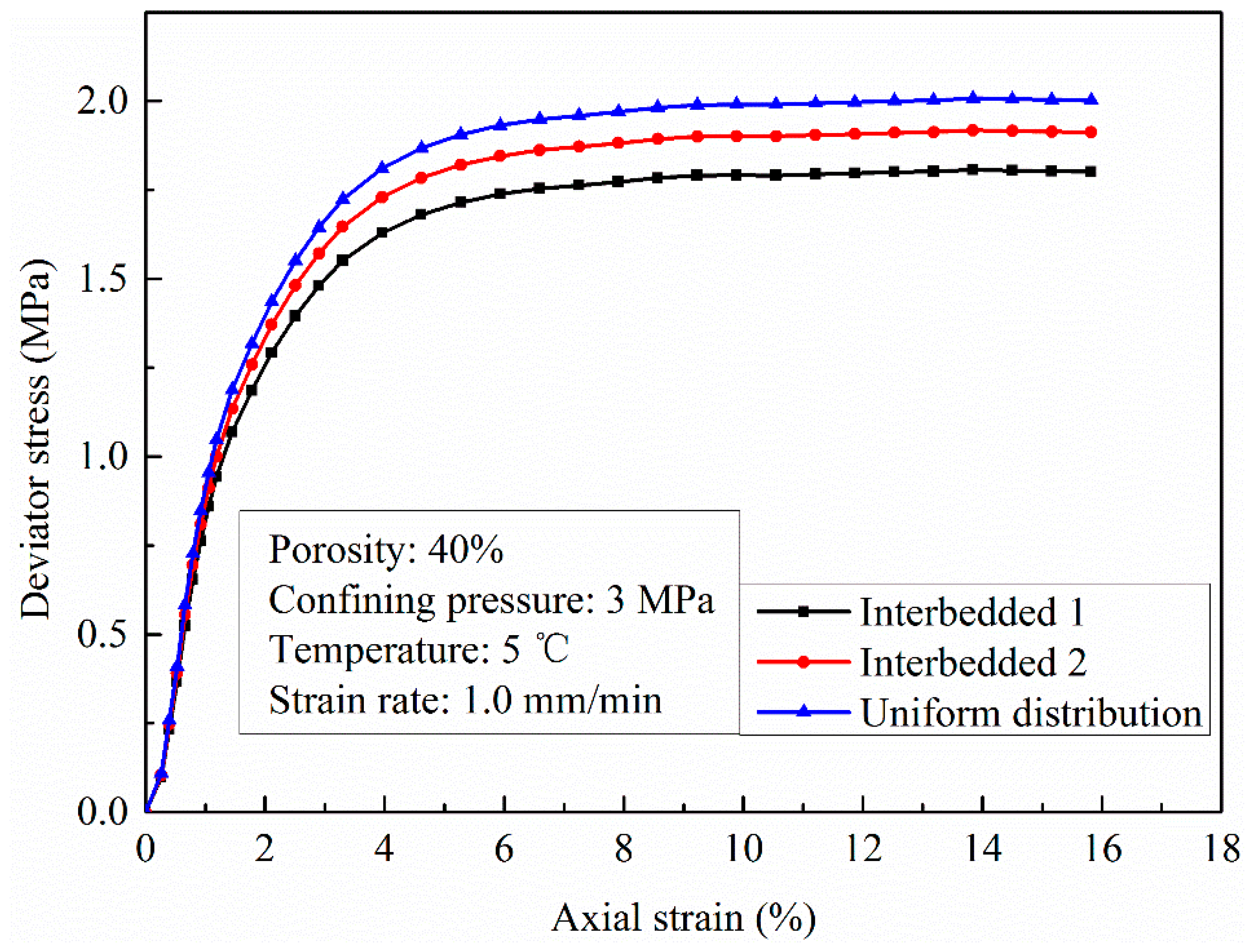

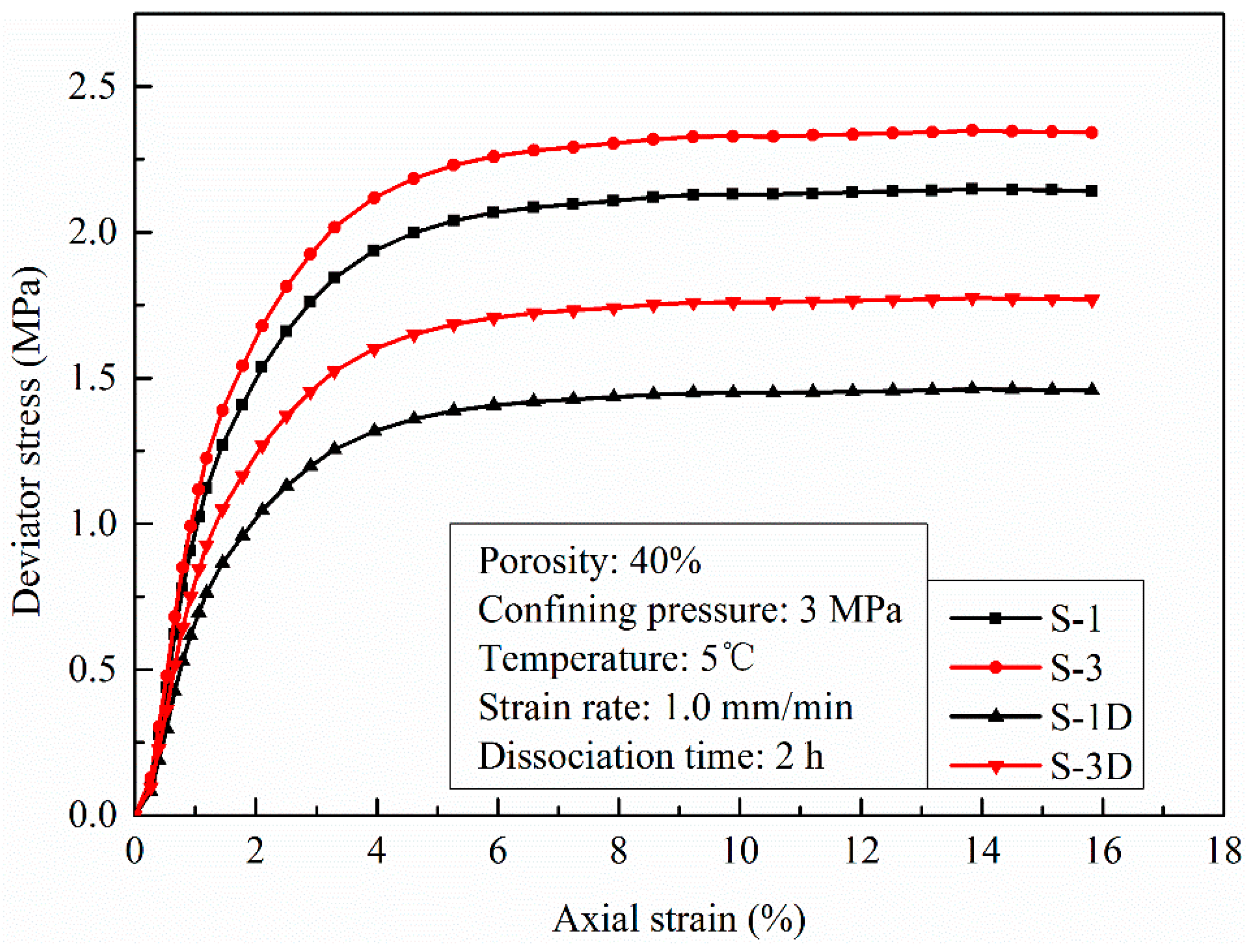

| Sediments | Particle Size | Mean Size (μm) | Depth (m) | ||||
|---|---|---|---|---|---|---|---|
| <1.5 μm | 1.5 μm–4 μm | 4 μm–10 μm | 10 μm–25 μm | >25 μm | |||
| S-1 | 9.07% | 18.71% | 31.89% | 25.16% | 15.17% | 9.165 | 128 |
| S-2 | 7.83% | 20.52% | 29.47% | 23.6% | 18.58% | 8.997 | 132 |
| S-3 | 14.01% | 23.97% | 20.81% | 20.88% | 20.33% | 7.976 | 133 |
| S-4 | 12.68% | 21.18% | 20.54% | 22.65% | 22.95% | 7.983 | 134 |
| S-5 | 9.99% | 20.82% | 33.52% | 22.34% | 13.33% | 7.925 | 158 |
| Artificial silt | 11.54% | 17.93% | 28.99% | 24.69% | 16.85% | 8.270 | |
© 2019 by the authors. Licensee MDPI, Basel, Switzerland. This article is an open access article distributed under the terms and conditions of the Creative Commons Attribution (CC BY) license (http://creativecommons.org/licenses/by/4.0/).
Share and Cite
Li, Y.; Luo, T.; Sun, X.; Liu, W.; Li, Q.; Li, Y.; Song, Y. Strength Behaviors of Remolded Hydrate-Bearing Marine Sediments in Different Drilling Depths of the South China Sea. Energies 2019, 12, 253. https://doi.org/10.3390/en12020253
Li Y, Luo T, Sun X, Liu W, Li Q, Li Y, Song Y. Strength Behaviors of Remolded Hydrate-Bearing Marine Sediments in Different Drilling Depths of the South China Sea. Energies. 2019; 12(2):253. https://doi.org/10.3390/en12020253
Chicago/Turabian StyleLi, Yanghui, Tingting Luo, Xiang Sun, Weiguo Liu, Qingping Li, Yuanping Li, and Yongchen Song. 2019. "Strength Behaviors of Remolded Hydrate-Bearing Marine Sediments in Different Drilling Depths of the South China Sea" Energies 12, no. 2: 253. https://doi.org/10.3390/en12020253
APA StyleLi, Y., Luo, T., Sun, X., Liu, W., Li, Q., Li, Y., & Song, Y. (2019). Strength Behaviors of Remolded Hydrate-Bearing Marine Sediments in Different Drilling Depths of the South China Sea. Energies, 12(2), 253. https://doi.org/10.3390/en12020253






